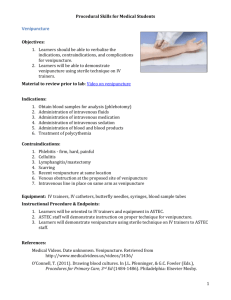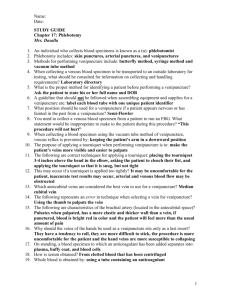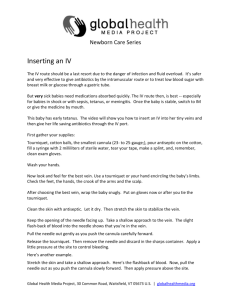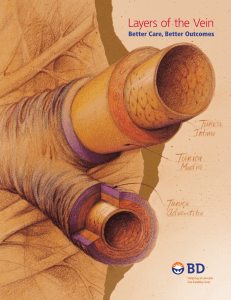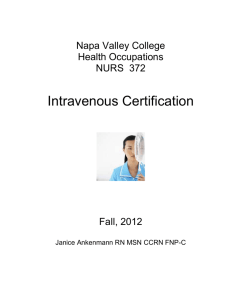Venipuncture - San Jose State University School of Nursing Spring
advertisement
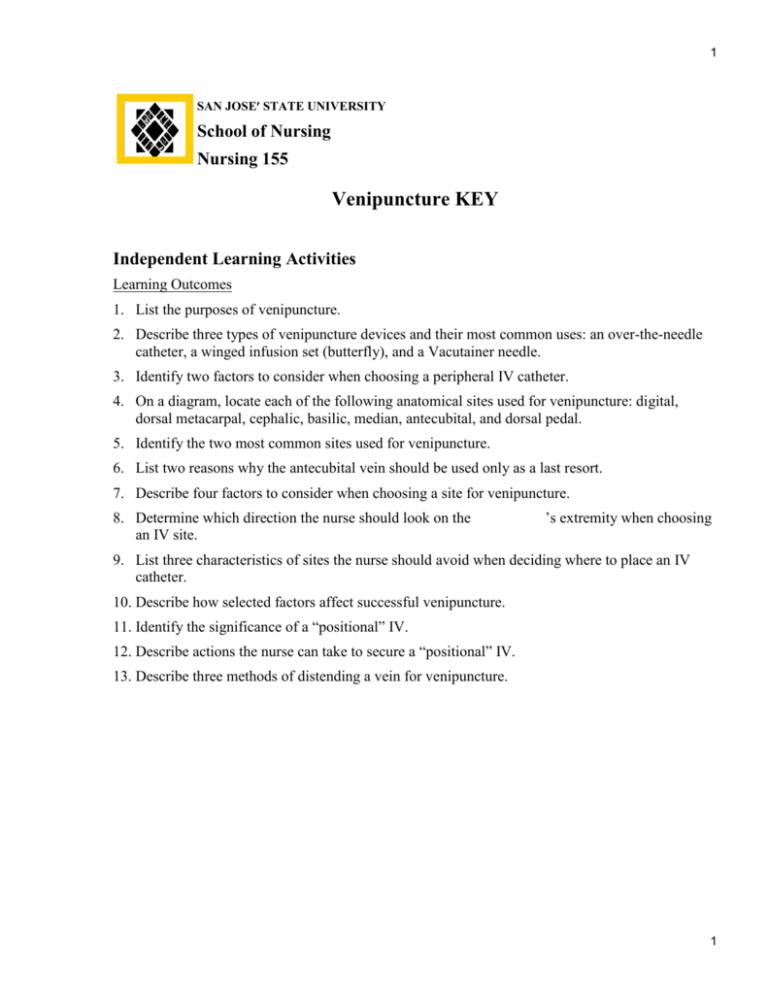
1 SAN JOSE STATE UNIVERSITY School of Nursing Nursing 155 Venipuncture KEY Independent Learning Activities Learning Outcomes 1. List the purposes of venipuncture. 2. Describe three types of venipuncture devices and their most common uses: an over-the-needle catheter, a winged infusion set (butterfly), and a Vacutainer needle. 3. Identify two factors to consider when choosing a peripheral IV catheter. 4. On a diagram, locate each of the following anatomical sites used for venipuncture: digital, dorsal metacarpal, cephalic, basilic, median, antecubital, and dorsal pedal. 5. Identify the two most common sites used for venipuncture. 6. List two reasons why the antecubital vein should be used only as a last resort. 7. Describe four factors to consider when choosing a site for venipuncture. 8. Determine which direction the nurse should look on the an IV site. ’s extremity when choosing 9. List three characteristics of sites the nurse should avoid when deciding where to place an IV catheter. 10. Describe how selected factors affect successful venipuncture. 11. Identify the significance of a “positional” IV. 12. Describe actions the nurse can take to secure a “positional” IV. 13. Describe three methods of distending a vein for venipuncture. 1 2 Learning Activities 1. The purposes of venipuncture are to: a. Collect a blood specimen b. Instill a medication c. Start an IV infusion d. Inject a radiopaque or radioactive tracer for special examinations e. Infuse blood or blood products 2. Briefly describe each of the following types of venipuncture devices and state the most common uses. a. Over-the-needle catheter Description: A hollow bore steel needle stylet inside a hollow plastic catheter. The steel needle stylet is used during insertion, then withdrawn, leaving the flexible plastic catheter in place. Uses: Short- term peripheral IV therapy. b. Winged infusion set (butterfly) Description: A hollow bore steel needle with plastic wings. This needle is easier to insert due to the wings, which provide grasping control during insertion; but is less desirable to use, because the steel needle must be left in the vein, and can increase the risk of infiltration. Uses: Short-term peripheral IV therapy. One-time infusion, IV push administration c. Vacutainer needle Description: Double-ended needle which attaches to a vacuum tube. The long end of the needle is used to puncture the vein, and the short end fits into blood tubes. Uses: Drawing blood. Multiple tubes can be filled with one venipuncture. 3. Write two factors to consider when choosing a peripheral IV catheter. a. Size of vein you intend to use b. Type of IV fluid or medication to be infused (fluids only, blood products, etc.) and duration of infusion c. whether or not the client is to undergo planned surgeries or procedures that require venous access. 2 3 4. On the diagrams, label the following veins used for venipuncture: digital, dorsal metacarpal, cephalic, basilic, median, antecubital, and dorsal pedal. Draw in veins that don’t show on the diagram. Put a star next to the 2 sites that are most commonly used. 5. Why should the antecubital vein be used only as a last resort? a. Limits client’s range of motion b. Catheter may become kinked, disrupting the fluid flow, due to its location in a joint of flexion 6. What are four factors to consider when choosing an appropriate vein for venipuncture? a. Client’s medical history b. Client’s age, size, and general condition c. Condition of the veins d. Type of IV fluid or medication to be infused 7. When choosing an IV site, where should the nurse look first? Circle the correct response. a. most proximal on the extremity, then move distally b. most distal on the extremity, then move proximally 8. When choosing an IV site, the nurse should avoid sites that are (list 3): a. Near a joint of flexion, such as the antecubital b. On the ’s dominant hand c. Have signs of infection, infiltration, or thrombosis 3 4 9. Describe how each of the following factors affect successful venipuncture: a. age Very old and very young clients have fragile veins; very old clients frequently have fragile skin and loss of subcutaneous tissue. Loss of subcutaneous tissue results in veins rolling, and therefore are more difficult to puncture. b. skin condition It is more difficult to locate superficial veins on obese clients or clients with edema. It is more difficult to puncture the vein of a dehydrated client. c. vein condition If veins are fragile, the nurse may puncture through the entire vein. Also, it is difficult to insert lines in clients who have had many venipunctures because their veins may be sclerosed with scar tissue. d. Type of IV cannula used The nurse must choose the proper gauge catheter for the vein s/he is attempting to puncture; a large gauge catheter will be more difficult to insert into a small vein and will obstruct the flow of blood around the catheter. 10. What does it mean when an IV is “positional”? The flow of fluid may be decreased or interrupted when a client changes his/her position, or the plastic catheter may move within the vein and not flow properly if taped in a particular direction. That is, the fluid infuses best when the extremity is in a particular position, or when the tubing is taped in a particular position. 11. Once the nurse identifies an IV as “positional”, what actions should be taken to secure the IV? Ensure IV is taped well in the position it infuses well. If it is due to client movement, explain to the client the IV flow is interrupted when s/he has too much movement from that arm, and enlist his/her assistance in limiting movement. If conservative measures do not work, an armboard may be used to immobilize the IV, however this is more awkward and uncomfortable for the client. 4 5 12. Briefly describe three methods of distending a vein for venipuncture. a. Placing a tourniquet 4-6 inches above the site intended for venipuncture. b. Place the extremity in a dependent position and ask client to open and close fist several times; rub or stroke client’s arm. c. Place a warm compress to intended area, increasing vasculature to the area, and wait 10-20 minutes. d. For clients with limited peripheral venous sites or sclerosed veins: apply a tourniquet to mid-upper arm and stroke downward toward hand. After 1 or 2 minutes, apply a second tourniquet just below the antecubital fossa and stroke downward. If the client is elderly, do not apply the tourniquet. 5

